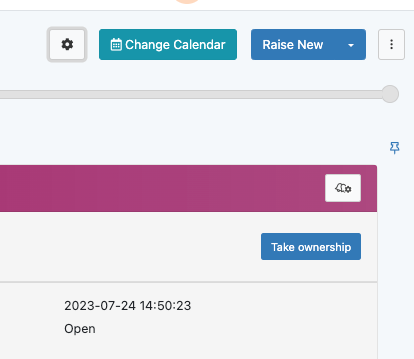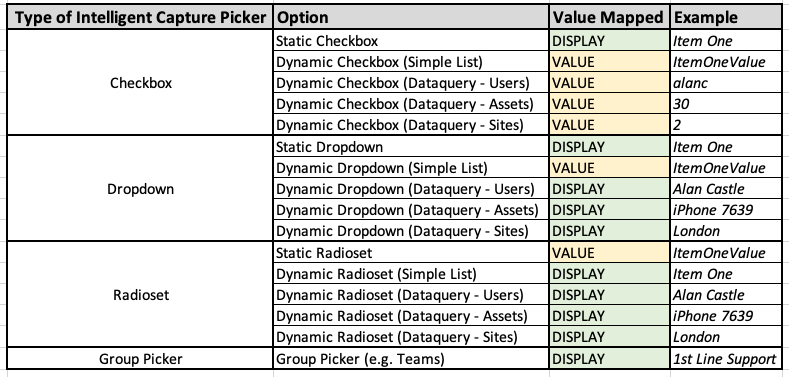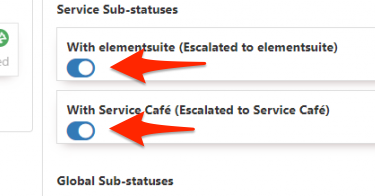-
Posts
242 -
Joined
-
Last visited
-
Days Won
16
Bob Dickinson last won the day on April 28 2023
Bob Dickinson had the most liked content!
About Bob Dickinson
- Birthday 26/08/1983
Profile Information
-
Location
Ruislip
Recent Profile Visitors
The recent visitors block is disabled and is not being shown to other users.
Bob Dickinson's Achievements
-

enhancement Additional Notice types
Bob Dickinson replied to Gareth Cantrell's topic in Service Manager
@Berto2002 Another option for your specific use cases could be to use the URL option that exists behind a custom button, so a Change Calendar button is easily achievable. The buttons can also have conditions applied to only appear in certain scenarios e.g. only show a button if the Service = New Starter -
Hi @Alisha If the same properties as the "General" class are suitable, you could create a Type underneath the General class for the individual items e.g. Cabinet, Safe etc for the time being? Usually a new class would have some specific properties relating to that type of asset. Or is there a reason why being Type specific wouldn't work for you in this scenario? Thanks Bob
-
Bob Dickinson started following Asset Roles - More permission options and granular permission
-

Task Assignment - Assign to Variable for Groups?
Bob Dickinson replied to CraigP's topic in Service Manager
Hi @CraigP I know it's been over a year - but here is how you can assign tasks to other entities if required: Hope this helps Bob -

Task Assignment - Assign to Variable for Groups/Roles
Bob Dickinson replied to Ade M's topic in Service Manager
Hi @Ade M It IS actually possible to use the "Assign to Variable" option on a Human Task to a User, Team or Role. You just need to use the correct syntax (I've noticed this isn't documented anywhere however, so will look to correct this). Also, this is not a free text field (at present) so the string will need to be injected in from somewhere else - possibly if you have stored the generated string in a custom field, that could be an option. The strings you need are: To assign to a Team urn:sys:group:<team ID> e.g. urn:sys:group:ABCCORP/bobteam/ To assign to a User urn:sys:user:<UserID> e.g. urn:sys:user:bobd To assign to a Role urn:sys:role:<role name> e.g. urn:sys:role:Asset Manager -

Report/Search showing where Simple Lists are used
Bob Dickinson replied to Stuart Torres-Catmur's topic in Service Manager
Hi @Stuart Torres-Catmur and others Although there isn't a simple way of reporting at present, we do have a search option that will help you identify the Intelligent Capture in which particular Simple Lists are used. In the Intelligent Captures screen, click on the small Magnifying Glass button and type in the exact name of the simple list, and click "Search". This will bring back all captures that have at least 1 occurrence of that list being used (and will tell you if it's used more than once in some captures too). Whilst it doesn't highlight the specific node in which it is used, it is a useful mechanism to filter down the captures to show you the relevant ones, and you know the list will be present somewhere within each. I hope this helps Bob- 7 replies
-
- 3
-

-
- enhancement
- simple lists
-
(and 2 more)
Tagged with:
-

Adding a Connection from a user captured in an custom field
Bob Dickinson replied to SJEaton's topic in Service Manager
Hi @SJEaton Just for future reference, if you are mapping directly from the Intelligent Capture into a Custom Fields (as opposed to setting a custom field in the Business Process), the type of field type and option that you have selected will impact whether the content of the custom field is the DISPLAY VALUE or the VALUE/RAW VALUE. In your example, because you mapped a Dropdown -> Data Query -> Get All Users to h_custom_b, this resulted in a Display Value rather than the Raw Value - hence why you got the error. I have tested this, and put together what is returned for each type of Intelligent Capture selection attribute that you may choose to map - see below. If the option you need is not on this list, then you will need to use the BPM to retrieve what you require, as opposed to a direct custom field mapping. Kind Regards Bob -
Hi @will.good That is what these toggles are for - if enabled, it means they will automatically update (i.e. come off-hold) after a customer update. If you want the request to remain on-hold after a customer update, simply switch these toggles off. You can see that the "With People Services" global sub-status already has this toggle switched off, hence why that is the only current one that is not auto-updated as part of a customer updated. Kind Regards Bob
-

Use database direct to update fields?
Bob Dickinson replied to Gary@ADL's topic in System Administration
Hi@Gary@ADL Why are you unable to edit this on the request itself? If it is due to the custom field not showing, you should be able to temporarily make h_custom_a visible on the Details section for that particular service, simply by clicking "Design" (as an Admin), adding a custom field e.g. Single Line Text Field, ensuring you select h_custom_a, and clicking "Apply Changes". This would then allow you to edit the value of the custom field via the Problem Record itself (rather than trying to do it via SQL which we do not allow). And once changed, you could hide the custom field from view again if you didn't want it visible going forwards. Bob -
Hi @Salma Sarwar If you are referring to the dropdown "Knowledge Center" that appears when you start typing (and overlaps the rest of the fields) - there is a system setting to turn this off: Go to Admin Select Platform Configuration Click on "Core Settings" Search for the setting "guest.anonymous.employeePortal.core.disable-knowledge-search-in-pro-cap" Turn this ON This will disable this function Kind Regards Bob
-
Giuseppe Iannacone started following Bob Dickinson
-
Hi @CraigP At the moment, only Incidents, Service Requests and Changes can be raised directly from the portal. There isn't a way to raise the other request types at present (Release, Problem, Known Error). A common approach might be to set up a Service Request item called "Request for Release" - where you could collate all of the information which results in a Service Request being raise, with it's own small process maybe containing an approval stage that decides whether the full Release is (manually or automatically) then raised based on the customers request. Hope this helps Bob
-
Hi @Sam P If you changed this to "Create and Update" I believe it would append these roles onto any existing roles that your users have, INCLUDING the full users. So whilst it wouldn't remove any access they have, this is still far from ideal as it means your Full Users would have roles that aren't relevant or necessary. My suggestion would be to go into the Admin area, to the Roles section (of the specific app) and navigate to one of the roles that you want to be added to all the Basic Users - e.g. "Self Service User". From there, there is a button called "Add All Users" and once, clicked you will have a prompt. Select the option User Type = Basic. If you then click "Save", this will apply that role to ALL of the basic users on your instance. Obviously most will already have that role, so nothing will happen to their accounts, but it would quickly add it to approx 200 accounts you mention that don't have that role. Then repeat this process for each of the roles that is missing. You will then be in a position where all Basic users will have all the required roles. And you would then just need to ensure that the process that you are now using to create new accounts has also been updated to add these roles in on creation, so you don't have to keep repeating this job. Kind Regards Bob
-
Hi @AlexOnTheHill This information is stored within the h_sys_reports table, in an column called h_definition. You'll notice that this column actually contains all sorts of information relating to the definition of the report, not just scheduled recipients. Due to this, to find what you need you would need to use an "Is Like" operator in the filter - so it can look at the whole string of text in h_definition and see if there is a match. In terms of the details held against the scheduled recipient, it actually stores their Name, Hornbill User ID, and Email Address. I have attached up a quick example report example you could load onto your instance that prompts the person running the report to enter the email address of the recipient who may be scheduled to recieve some reports - and the results should return the titles of any reports that meet this criteria. Hope this helps Bob reports-by-scheduled-user-prompt.report (1).txt
-
Hi @will.good Try using the "Add (" and "Add )" buttons to put brackets around the first 3 category related criteria. So it should be: (Category Name = Workplace OR Category Name = McHire OR Category Name = MyStuff) AND Date Logged is between Start of Yesterday & End Of Yesterday Kind Regards Bob
-
Hi @QEHNick What you have posted is basically "How many customers have each department set against their profile". If that is what you want, that is fine (with a couple of tweaks as per below - for example I've added a filter to only show customers who have an "active" status. HOWEVER - This has nothing at all to do with requests logged whatsoever as there is no link to the requests table. If you want to use this particular widget in analytics to show this info, there may possibly be a way of manipulating the data, but it will take a little while to work out and I'm not 100% sure its possible. However the main issue with it, is that it could vary - e.g. Bob is a member of the HR department. He logs a new request on Monday. Nick checks the chart and sees "1 request logged this week from the HR department" Later that week, Bob joins the IT department. Nick checks the chart again, and now sees "0 requests logged this week from the HR department, but 1 logged for the IT department" - despite the fact Bob logged it when he was working for HR. So this data is being collected at the point of time the report is run rather than it being a true reflection of the department at the time of logging. The solution - I'm not sure if you are doing this already. But if you have a spare unused custom field across the board, at the very start of every Business Process you could GET the customers attrib 3 field and write this value to your custom field on the ticket (it would have to be the SAME custom field used on every process e.g. h_custom_m or something). This will never change - and you can do all of your reporting from that custom field on the main request table (h_itsm_requests) rather than the table you have used above. The downside is that this will be a bit of work if you have lots of processes, so perhaps only do it on the ones you are keen to measure, and also you can't backdate this so it would only be applicable to tickets logged from the moment you save the new workflows. But it makes the reporting much easier and more accurate. However if you still want to go down the first method, let me know and if I get a few mins I'll see if anything at all could be done on that widget.
-
Hi @QEHNick What is the specific requirement? i.e. what would you like your widget to display. Thanks Bob













